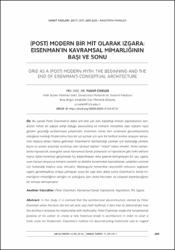| dc.contributor.author | Civelek, Yusuf | |
| dc.date.accessioned | 2021-05-28T10:16:23Z | |
| dc.date.available | 2021-05-28T10:16:23Z | |
| dc.date.issued | 2017 | en_US |
| dc.identifier.citation | CİVELEK, Yusuf. "(Post) Modern Bir Mit Olarak Izgara: Eisenman’ın Kavramsal Mimarlığının Başı ve Sonu". Sanat Yazıları, 37 (2017): 209-228. | en_US |
| dc.identifier.uri | http://sanatyazilari.hacettepe.edu.tr/img/11243024112017__9603692889B.pdf | |
| dc.identifier.uri | https://hdl.handle.net/11352/3565 | |
| dc.description.abstract | Bu yazıda Peter Eisenman’ın daha ismi bile yok iken başlattığı mimari yapısökümün kendisinin
mitsel bir yapıya sahip olduğu savunulmuş ve mimarın mitsellikle olan ilişkisini nasıl
gözden geçirdiği açıklanmaya çalışılmıştır. Eisenman henüz tam anlamıyla gerçekleşmemiş
olduğuna inandığı Modernizme taze bir yol açmak için yeni bir tarihsel kırılma arayışını kariyerinin
başlıca amacı haline getirmişti. Eisenman’ın tarihselciliği çözmek için kullandığı yöntem,
biçim ve anlam arasında kurulmuş olan tarihsel ilişkileri “mitsel” kabul etmekti. Farklı zamanlarda
Yapısalcılık, avangard sanat, Kavramsal Sanat, psikanaliz ve Yapısöküm gibi farklı etkilere
maruz kalan kuramsal gelişiminde hiç kaybolmayan ama giderek belirginleşen bir şey, ızgara,
uzun kariyeri boyunca mimarın sentetik ve eklektik kuramından kaynaklanan çelişkileri çözmek
için kullandığı başlıca araç olmuştur. Başlangıçta mimarlıkta rasyonellik mitosunu sağlayan
ızgara gerekmedikçe ortaya çıkmayan soyut bir yapı iken, daha sonra Eisenman’ın, kendi mimarlığının
mitselliğinin varlığını ve yokluğunu aynı anda ima eden ve üslupsal diyebileceğimiz
bir temaya dönüşmüştür. | en_US |
| dc.description.abstract | In this study, it is claimed that the architectural deconstruction, started by Peter
Eisenman when the term did not yet exist, was itself mythical; it also tries to demonstrate how
the architect reviewed his relationship with mythicality. Peter Eisenman made the fundamental
purpose of his career to create a new historical break in architecture in order to clear a
fresh route for Modernism. Eisenman’s method for deconstructing historicism was to regard the historical connections between form and meaning as “mythical”. One thing, the grid,
which became even more perceivable instead of disappearing in his theoretical evolution
that was subjected to various effects at various times, such as Structuralism, avant-garde art,
Conceptual Art, psychoanalysis and Deconstruction, has always been his main tool to solve
the contradictions resulting from his synthetic and eclectic theoretical approach. Initially, the
grid was an abstract structure which provided the myth of rationality. Later on, it became a
theme which we may call stylistic, implying at the same time the presence and absence of the
mythicality of his architecture. | en_US |
| dc.language.iso | tur | en_US |
| dc.publisher | Hacettepe Üniversitesi | en_US |
| dc.rights | info:eu-repo/semantics/openAccess | en_US |
| dc.subject | Peter Eisenman | en_US |
| dc.subject | Kavramsal Sanat | en_US |
| dc.subject | Yapısalcılık | en_US |
| dc.subject | Yapısöküm | en_US |
| dc.subject | Mit | en_US |
| dc.subject | Izgara | en_US |
| dc.subject | Peter Eisenman | en_US |
| dc.subject | Conceptual Art | en_US |
| dc.subject | Structuralism | en_US |
| dc.subject | Deconstruction | en_US |
| dc.subject | Myth | en_US |
| dc.subject | Grid | en_US |
| dc.title | (Post) Modern Bir Mit Olarak Izgara: Eisenman’ın Kavramsal Mimarlığının Başı ve Sonu | en_US |
| dc.title.alternative | Grid As a (Post) Modern Myth: The Beginning and the End of Eisenman’s Conceptual Architecture | en_US |
| dc.type | article | en_US |
| dc.relation.journal | Sanat Yazıları | en_US |
| dc.contributor.department | FSM Vakıf Üniversitesi, Mimarlık ve Tasarım Fakültesi, Mimarlık Bölümü | en_US |
| dc.contributor.authorID | https://orcid.org/0000-0003-4754-4737 | en_US |
| dc.identifier.issue | 37 | en_US |
| dc.identifier.startpage | 209 | en_US |
| dc.identifier.endpage | 228 | en_US |
| dc.relation.publicationcategory | Makale - Uluslararası Hakemli Dergi - Kurum Öğretim Elemanı | en_US |
| dc.contributor.institutionauthor | Civelek, Yusuf | |



















